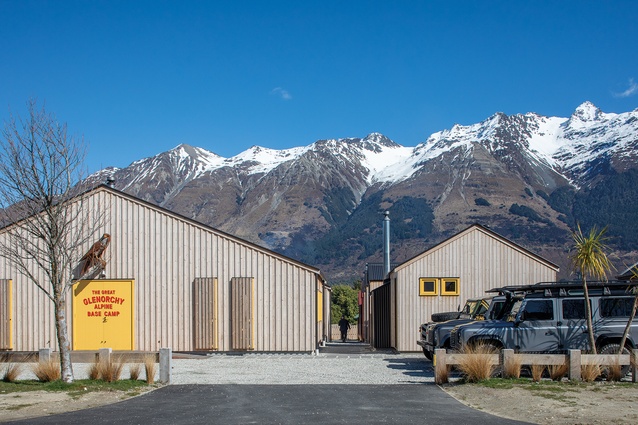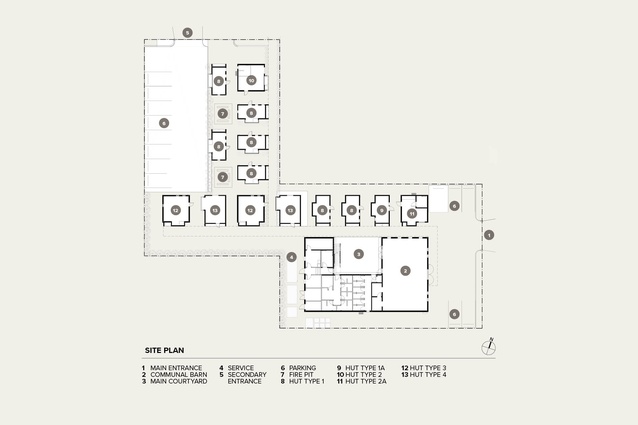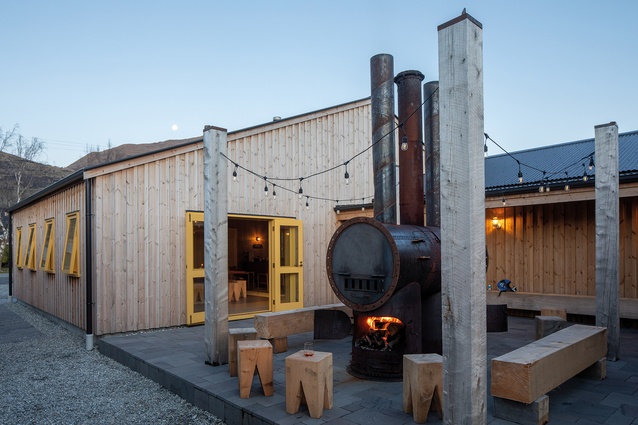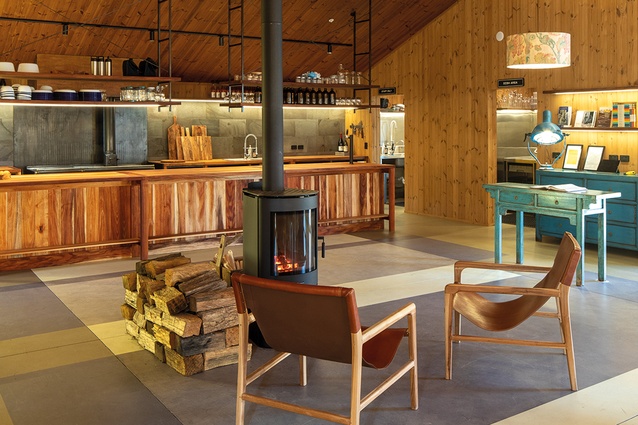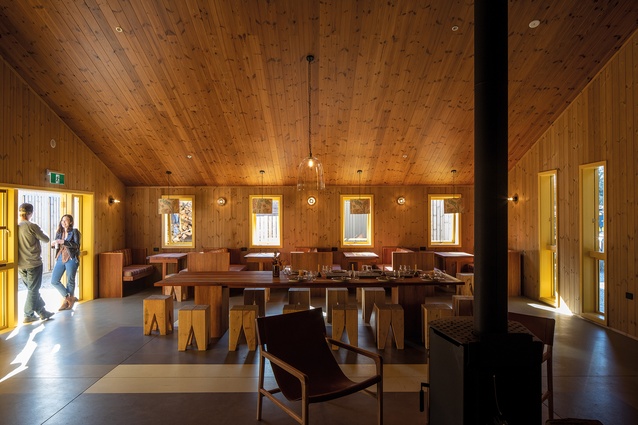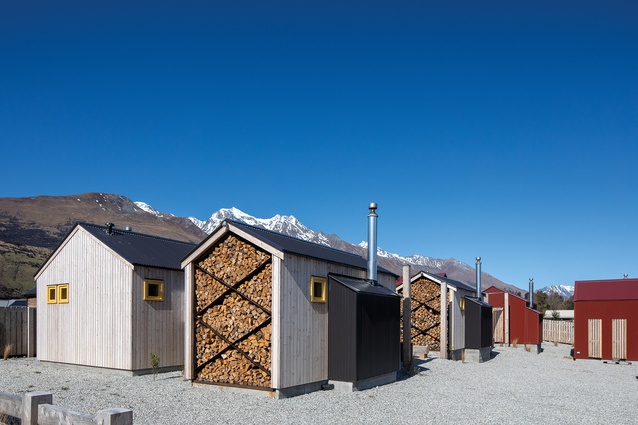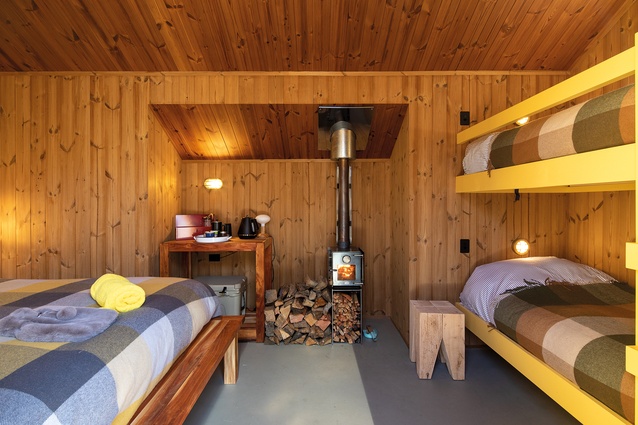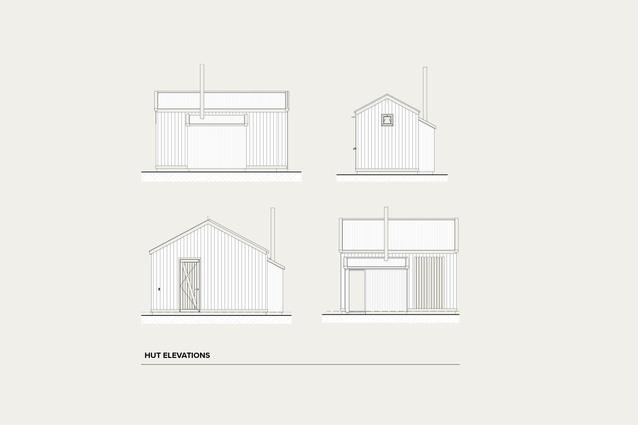Vernacular adventure
The Great Glenorchy Alpine Base Camp is a thorough-going realisation of a distinctive commercial model: bespoke architecture in the service of bespoke adventure.
In both a design and a business sense, the enterprise pitches its tent (excuse me) in highly resonant territory. Hollywood — and the cinematic quality of the project encourages moviemaking analogies — would recognise it as a high-concept proposition. You could say, given that mining metaphors in this part of Otago are as irresistible as the lure of gold once was, that The Great Glenorchy Alpine Base Camp exploits a rich seam of settler typologies and memes.
It’s quite a title: ‘The Great Glenorchy Alpine Base Camp’. Aside from its assertion of superlative status, the name acknowledges the setting of a village remotely sited at the confluence of the Dart River/Te Awa Whakatipu and Lake Wakatipu, subject to the increasing gravitational pull of the Queenstown tourism industry. The property sits at the doorstep of Te Wāhipounamu-South West New Zealand, a UNESCO World Heritage Site comprising the 2.6 million hectares of the Westland Tai Poutini, Aoraki/Mount Cook, Fiordland and Mount Aspiring National Parks. The Humboldt Range is to the west, the Richardson Range to the east, and Pikirakatahi/Mount Earnslaw to the north. At Glenorchy, the mountains are just implacably there; if you need a reminder of the transience of human existence, this place will provide it.
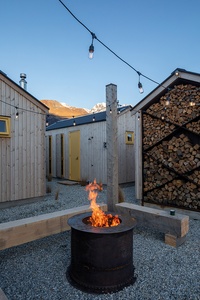
There’s further meaning in a name which puffs along its semiotic track like a small steam train. ‘Base camp’ is a laconic phrase with heroic connotations. The term is taken, of course, from the lexicon of alpinism, the apex leisure activity of Te Wāhipounamu. (Southern Alps mountaineering, as any trawler through the shelves of second-hand bookshops will know, has generated an intensity of commitment out of all proportion to the numbers of its participants). But ‘base camp’, in Aotearoa, is more specifically evocative. It calls to mind the 1953 Everest expedition and the most epochal moment in the life of the 20th century’s most famous New Zealander: Edmund Hillary’s pioneering ascent, with Tenzing Norgay, of the world’s highest mountain.
‘Camp’ is the caboose in the train of this title, a habitational genre that only rarely qualifies as architecture: no-frills and provisional and, as evidenced in many troubled parts of the world, liable to transition from short-term shelter to semipermanent settlement. It’s a versatile category, encompassing the lightweight presence of holiday tents in a summer meadow and a heavy history as the rough quarters for men involved in sanguinary frontier business: Roman legions in Gaul and British regiments in the Waikato; fur traders in Hudson Bay and sealers in Fiordland. In mid-twentieth-century New Zealand, the camp became synonymous with nation-building projects, such as the construction of the dams in the country’s hydro-power network.
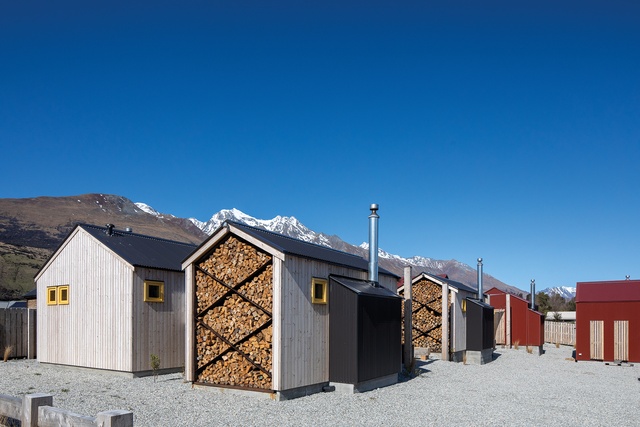
The New Zealand public works camp, with its ordered rows of small timber huts, was an initial design prompt for The Great Glenorchy Alpine Base Camp. Owner Doug Rikard-Bell – Architecture NZ readers may recall his involvement, a dozen years ago, in the ambitious and ultimately abortive Rhubarb Lane scheme in Auckland – originally envisaged the project in his new home town as worker housing. (This commodity, as constant reports make clear, is in short supply in the Queenstown Lakes District.) Pivoting from this plan in the direction of upmarket activity tourism, Rikard-Bell developed a scheme incorporating the vertical integration of customised adventure and appropriate accommodation. The camp was recast as a launch pad for guided alpine excursions — climbs, heli-hikes, glacier traverses and overnight bivouacs.
RTA Studio and Bureaux. RTA masterplanned The Great Glenorchy Alpine Base Camp and designed its constituent structural elements; the studio then collaborated with Bureaux, and a very engaged client, on the design of the facility’s functional requirements and its experiential dimension. (To a significant degree, the design project, in its material selection and referential gestures, such as the taps and little mirrors on the outside of the huts, was about vibes generation).
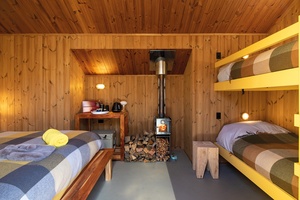
RTA director Richard Naish took inspiration from the region’s history of Man Alone-type dwellings, including the huts, a few of which have survived on nearby Mount Judah, that in the middle of last century housed workers mining scheelite, the ore containing tungsten used in armaments manufacture. One such surviving shack is Boozer Hut, named for its particularly alcoholic 1930s’ occupant. Naish could also draw on his own practice’s precedents — RTA’s portfolio includes several examples of hut/shed allusion, among them the cabin (2015) Naish designed for his family in the Cardrona Valley.
RTA laid out the 14 huts of The Great Glenorchy Alpine Base Camp along the two arms of the site’s right angle. (The development abuts a corner section under different ownership). The gabled huts, some clad in the thermally modified Nordic timber product Lunawood — the top performer in the client’s carbon analysis of timber options — and others in corrugated steel, come in four types, the smallest of which is roughly four by two metres. They house various combinations of beds and/or bunks. (In one hut type, a head for heights would be the trait determining occupation of the topmost bunk in a three-high stack).
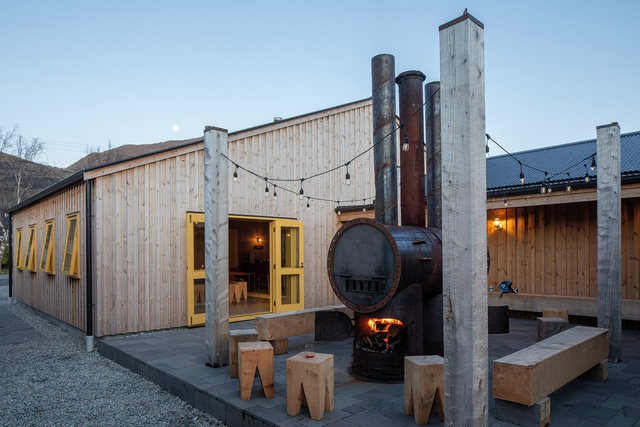
Huts on the east-west axis flank the building containing the kitchen, dining room, laundry, office, storage and communal bathroom facilities, and sheltering a courtyard with a large, steampunk-ish wood-burner. The front of this larger building is the public face of the project. With its plain façade of vertical timber boards and the yellow pop of its front door, it contributes a moment of design coherence to Glenorchy’s main drag, which straggles along in informal New Zealand small-town fashion. In contrast, the lintel-top ornamental falcon by local steel sculptor Dan Kelly could be seen as a salute to the area’s robust industrial tradition.
The self-possessed character of the main building’s street elevation is a signal of an hermetic intent also expressed by the small timber-framed windows and fixed shutters of the individual huts. Deliberately, Rikard-Bell says, a stay at The Great Glenorchy Alpine Base Camp, just like occupation of a mountain cabin, is experienced as “closedness”. This preserves the Brigadoon-level conceit of the ‘alpine base camp’ (and, besides, there’s more than enough openness, all around). The outside world is left behind in passing from the forecourt into the ‘Communal Barn’, the project’s hospitality hub: one big room, with a kitchen and bar along one side, banquette seating along the other, and a big table in between. The room is an exercise in cocooned conviviality – reminiscent not so much of a DOC hut as a wellappointed rifugio above an alpine trail in the Dolomites.
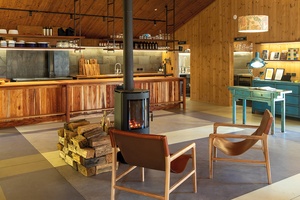
One person can staff the ‘barn’. There’s help available at busy times — The Great Glenorchy Alpine Base Camp could accommodate around 60 guests, but Rikard-Bell says half that number is probably ideal — and guests are encouraged to muck in and clean their dishes. Even so, this is a challenging staff-to-guest ratio, considerably — and justifiably, it must be said — reliant on employee competence and personality.
Unsurprisingly, much of the thinking around the project’s programme was devoted to reconciling effectiveness and affectiveness. Hence, says Bureaux director Jessica Barter, the concept of ‘Mama’s Kitchen’: “You can have someone standing in the kitchen, preparing a meal for everyone. They can welcome people as they come through the door, but the kitchen is not set up for staff to put the food out. The idea is that guests come and help themselves, and put their dishes away.”
The devolving of tasks extends into the private realm. As the architects acknowledge, there’s a social engineering aspect to giving guests responsibility for restocking wood and feeding the huts’ little woodburners, and having them crunch across cold pebbles to the communal bathrooms. “You’re not at your city house,” as Naish says. The Great Glenorchy Alpine Base Camp is overtly low-tech: connected to the grid but substantially wood-powered. Operationally, its footprint is light — the purpose of a stay is to be out and about — and, in the quality–quantity debate over tourism in Aotearoa, the project is firmly on the side of lower numbers (and higher value). These are, consciously, mitigating measures at a climate-critical time and in a mountain region scarred by a legacy of unsustainable extractive practices but now officially recognised as being of “outstanding value to humanity”.


